“Grooving machining produces intricate geometrical features for the perfect fit of parts, combining accuracy with efficiency”
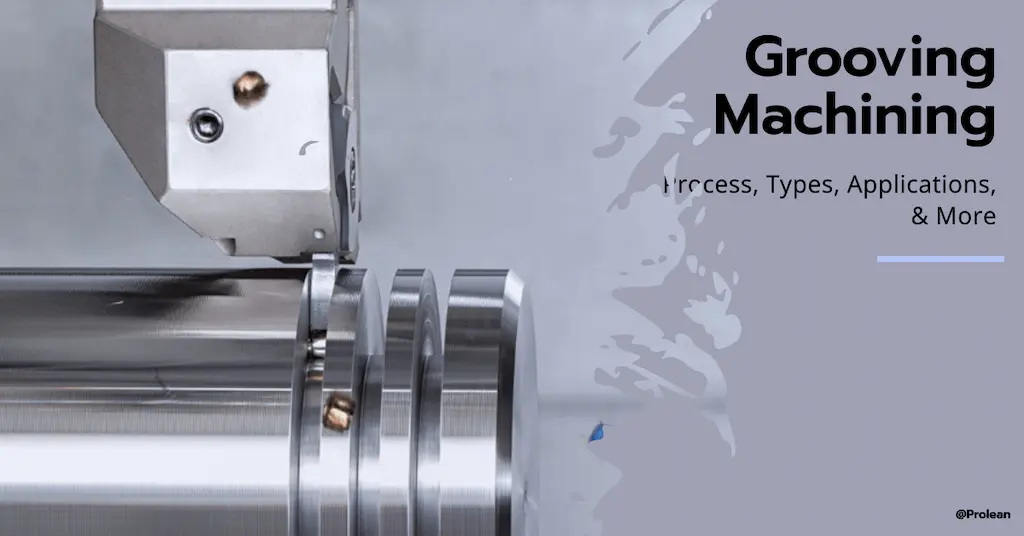
First, what is a groove? It refers to a narrow and long cavity or recesses on the workpiece. Grooves are critical geometric features in manufacturing, typically made to fit with secondary components like seals, gaskets, O-rings, etc. Therefore, grooving machining creates slots and grooves for assembly clearances, joints, fittings, or specific functionality. The CNC grooving technology uses lathes, turn machining centers, or other equipment to create grooves by removing the material in a definite path. A pre-loaded computer instruction file controls all tool movements and other auxiliary systems.
Understanding the process, types, tooling, and other technical aspects can help you make better decisions regarding your groove machining project. This article will guide you through the working principle, tools, types, and applications.
What is Grooving Machining?
It is subtractive manufacturing where a suitable grooving tool feeds the rotating workpiece and creates a tiny-sized cavity (open or closed ) that extends to a considerable length. Meanwhile, the shape of the groove can be cylindrical, corner, trapezoidal, or any irregular profile. The tool is attached to the tool post, which can move into multiple directions to shape the workiece.
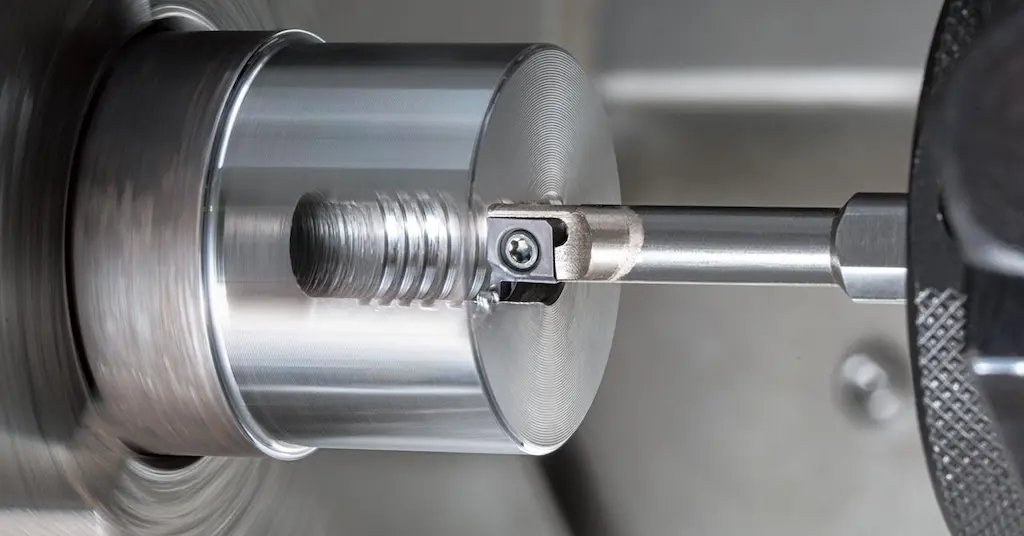
Grooving machining
Grooving machining can be external and internal; If grooves are formed on the surface exterior, called external grooving. On the other hand, internal grooving deals with the internal surface of hollow sections.
Try Prolean Now!
Types of Grooving Operations
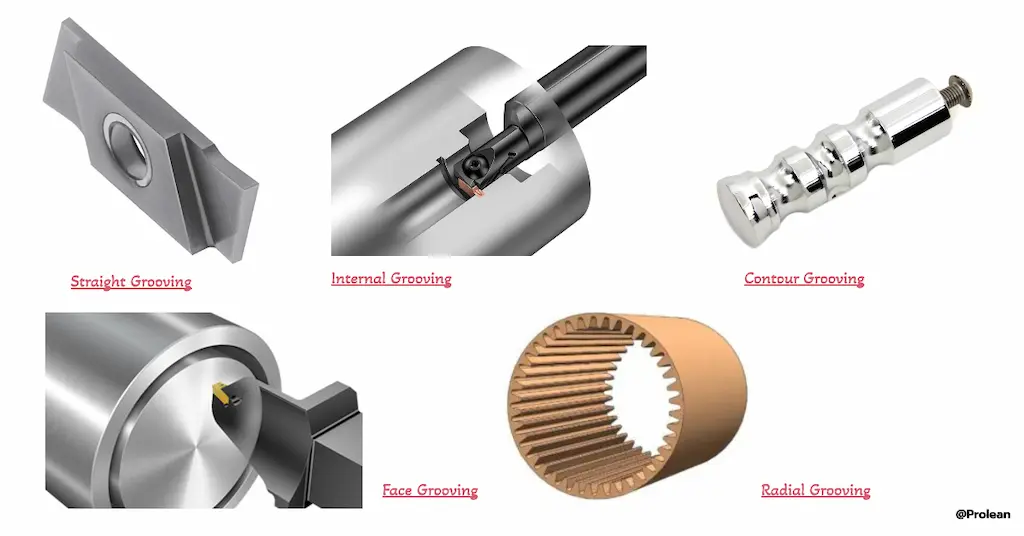
Types of groove machining
There are several types of grooving based on the groove profile, size, tooling, and application suitability. Using the right type according to the specifications of grooves in design. Here are some frequently used CNC grooving operations.
- Strength Grooving
It is the most simple form of grooving machining, open grooves along the length of cylindrical workpieces. Straight grooves make step-up diameters and custom grooves for specific purposes.
- Face Grooving
As the name suggests, it refers to creating grooves on the upfront face of the workpiece by aligning the tool in an axial direction with the workpiece. The face grooving tool inserts can reach the machining areas otherwise that are challenging with other groove cutting processes.
- Internal and External Grooving
These grooving machining types are categorized according to the machining surface; Internal Diameter Surface and External Diameter Surface.
The internal grooving creates various grooves of slots and internal hollow surfaces. The grooving tool tip remains slightly above the center-axis line of the workpiece. For example, the interior of a steel tube. On the other hand, external grooving works on the external surface. It can also be done with the milling cutter tooling.
In both external and internal grooves, their profiles can be linear, irregular, contour, or any custom shapes. These are typically used for fitting and sealing.
- Contour Grooving
It refers to custo grooves of specific shapes rather than liner, circular, cylindrical, or other standard geometrical geometries. Basically, the complex irregular contours.
- Axial and Angular Grooving
Axial grooving refers to groves parallel to the workpiece axis, which is common for groping on cylindrical surfaces, eg. keyways, shafts, etc. On the other hand, grooves with a specific angle with the workpiece axis are called angular grooves.
Grooving With CNC Machines
The CNC machines provide speed, accuracy, and precise grooving in various types of workpiece materials. Whether CNC lathe or milling machine, they automate the grooving tool movement. Like every other CNC machining process, CAM software converts the groove design into a file containing instructions for tools and other various auxiliary supports, called G and M codes. (E.g. G01: Groove Opened) Then, the machine follows the instructions and executes the grooving machining process.
The CNC grooving accommodates different tools and can follow the intricate machining path. However, the right tool selection is also crucial like other techniques.
Advantages
- Consistent and highly accurate groove cutting
- Low human intervention and reduced human resource cost
- CNC groovers can work on a wide range of materials; metals, plastics, composites, etc.
- Compared to conventional grooving, it is cost-effective across all production volumes.
- Lower material wastage from the workpiece
- It makes complex grooving shoes or patterns.
Materials Suitable for Grooving Machining
You can process metals, alloys, thermosets, composites, and thermoplastics with CNC grooving machining. The tool material and machine variable differ from one type of work material to another, They respond differently to the tool movement according to their properties.
Metal and Alloys
Hard metals like tool steel, titanium, nickel, and alloys require grooving tool inserts with a hard coating like carbide, diamond, or tungsten-carbide. Also, the grooving speed is fast for soft metal like, whereas it is relatively slower with the tough work materials.
- Aluminum
- Brass
- Copper
- Steel and stainless steel alloys
- Titanium
- Nickel alloys, etc.
Plastics Materials
Plastics are critical in machining as slight heat buildup can affect the workpiece, especially in deep grooving. So, optimal cutting speed, coolant flow, and tooling considerations are effective ways to avoid this.
- Acrylic
- Acrylonitrile Butadiene Styrene (ABS)
- Polycarbonate
- Teflon(PTFE)
- Polyoxymethylene (POM, Acetal)
Other Materials
Besides plastics and metals, you can create groove features on ceramics and composites.
- Alumina and Zirconia
- Carbon Fiber Reinforced Polymer (CFRP)
- Glass Fiber Reinforced Polymer (GFRP)
- Kevlar Reinforced Composites, etc.
Grooving Machining Tips
A slight deviation in groove machining parameters or misalignment significantly impacts the accuracy and overall production quality. So, some minor considerations help to achieve smooth operation and intended results.
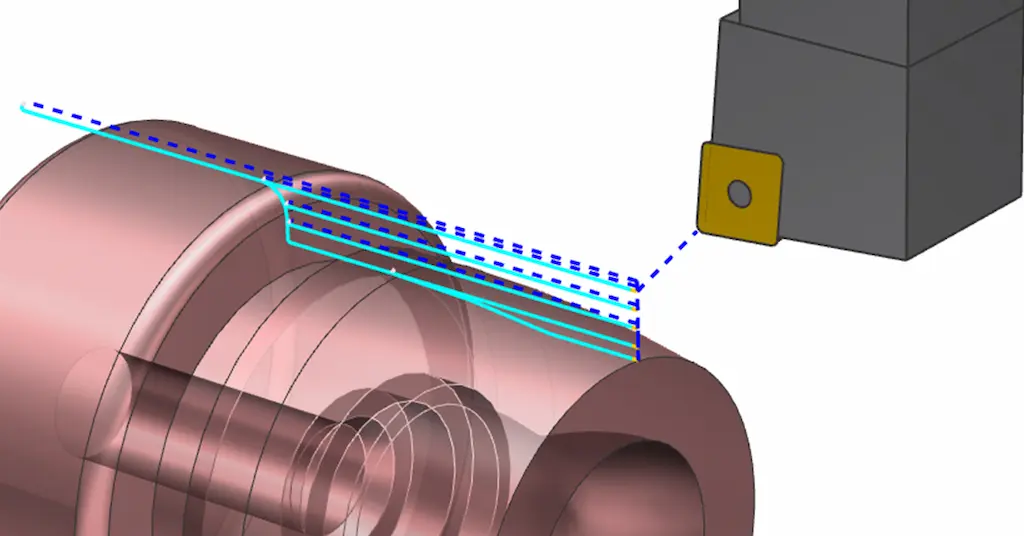
Designing the grooves
The following are some tips you can consider during grooving machining;
Ensure Machine Stability
Machine stability not only includes strong base or ground support but also perfect fitting and setup of each machine component so that they create minimal vibration during the grooving process.
Workpiece Clamping Force
The lower clamping force loosens the workpiece, whereas higher force can cause material deformation. Therefore, using the right clamping force is essential. Typically, the Clamping force is higher than the cutting force.
Clamping force = 1.5 to 2 x Cutting Force , or Fc ≤F clamp ≤ 2Fc
Grooving Tool and Workpiece Alignment
Any error in alignment between the grooving tool and the workpiece results in inaccuracy, tool defection, wear, and breakage. So, follow a proper calibration for their positioning and alignment before machining.
Selection of the right Groovin Tool
It is also critical to choose the right grooving tool and inserts based on the shape, size, and profile of the grooves. Consequently, there should be compatibility between tool material and work material.
- Parting tools
- Internal and external diameter diameter grooving cutters
- Full-radius grooving cutters, etc.
Radial Feed Roughing
It involves removing large amounts of material and creating a near-net-shaped groove before the finer passes for final depth. It is done by feeding the tool radially into the workpiece. You can follow this technique if you need a speedy process rather than high precision.
Efficient Chip Removal
Typically, there are two ways for chip removal in CNC grooving width bent or rolling chips. Ensure the grooves are wider than the chip’s length to avoid heat build-up. Using the right type of coolant also tackles the thermal impacts efficiently.
A slight deviation in groove machining parameters or misalignment significantly impacts the accuracy and overall production quality. So, some minor considerations help to achieve smooth operation and intended results.
Try Prolean Now!
What are the Applications of Grooving Machining?
The grooving machining operations are used in precise fitting elements, assembly clearance, gear manufacturing, etc. The table below outlines the application examples;
| Application | Benefits | Parts and Components Examples |
| Sealing ring grooves | They ensure the placement of O-rings for fluid and gas seals | Valves, pumps, fuel injectors, pistons, and hydraulic components manufacturing. |
| Snap-fit grooves | Precision slots for snap-fit components in mechanical assembly | Hosing and enclosures, battery covers, keyboard panels, toys, etc. |
| Retention grooves | They hold components like clips or rings securely in a specific position | Shafts, electrical motors, turbine rotors, couplings, spacers, etc. |
| Cooling channels | Management of surface area for efficient heat dissipation | Heat sinks, electronic cooling plates, transformers, EV batteries, etc. |
| Cable management grooves | Guiding and securing electrical cables or hoses | Automotive interiors, electrical control panels, robotics, industrial machinery, etc. |
| Gear manufacturing | Grooves for gear teeth for smooth motion transfer | Spur gears, helical gears, bevel gears, worm gears, etc. |
What is CNC V- Grooving?
The CNC V grooving refers to the creation of V-shaped grooves at the bending position of sheet metal. It helps bending without deformation and adjusts of bending radius. Different CNC V bits of varying angles (60, 90, 120°, etc.) are used in this process.
These V grooves of thick sheets also reduce the bending force and facilitate the positioning or alignment of the bending line. They are used in decorative parts, electronics panels, enclosure bending, HVAC duct bends, and other similar applications.
What is Deep Grooving?
Although there is no such definition or value for the depth of deep grooving, it is typically half of the workpiece thickness. If the workpieces are thin ( <1.5 mm), swiss lathes or turning machines are used for deep grooving, which can be up to 0.5mm deep only.
Ensuring the tool access, correct feed rate, and speed, and considering the right tooling are essential for accurate deep grooves. Otherwise, it will cause low flatness of the groove bottom, poor finish, material deformation, cracking, or even failure.
Try Prolean Now!
Summing Up
The grooves are essential for sealing, snap-fit assembly, cooling channels and cavities, gear manufacturing, and other many applications. The use of the right grooving tools, machining variables, and considering the work material ensures seamless grooving operations and optimal results.
Moreover, the expertise of engineers and operators, capabilities of grooving machinery, and quality control protocols equally impact the quality of machined grooves. Thus, consider these factors if you’re ordering the components with grooves or other related features.
At ProleanTech, we have advanced lathes, turning machines, V-groovers, and other machinery with custom tooling facilities. Our engineers first simulate the process on the computer and then execute the process with optimal parameters. So, get grooving quotes from us if you need any related services.
FAQs
What are the most common grooving tools in practice?
Based on profile, depth, and other characteristics different tools are used for grooving;
- Solid Carbide Tools
- Inside and Outside Diameter Tools
- HSS Tools
- Insert-based Tools
Are parting and grooving similar to each other?
Although they both involve the creation of narrow channels or slots, butt they severs different purposes. Parting separates a workpiece, whereas grooving crates specific slots or channels on the workpiece surface at a certain depth.
What is the right order of operation for CNC grooving?
The correct order for CNC grooving includes machine setup and workpiece clamping, positioning, alignment, running the G & M-codes, and monitoring the tool passes.
What does it mean by inserts in grooving machining?
Inserts are replaceable cutting tips that fit into tool holders. They are designed with specific geometries to cut grooves in a workpiece.
Which tool is suitable for large-sized grooves?
Large inexorable inserts are suitable frot large-sized grooves due to their better chip control and heat dissipation.

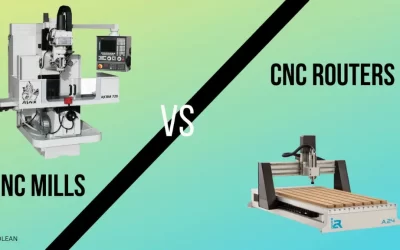
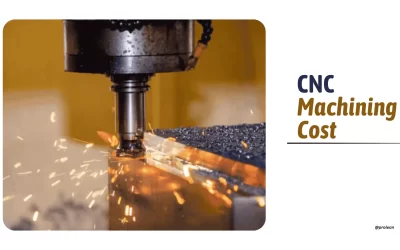
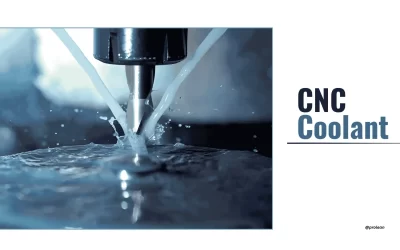
0 Comments